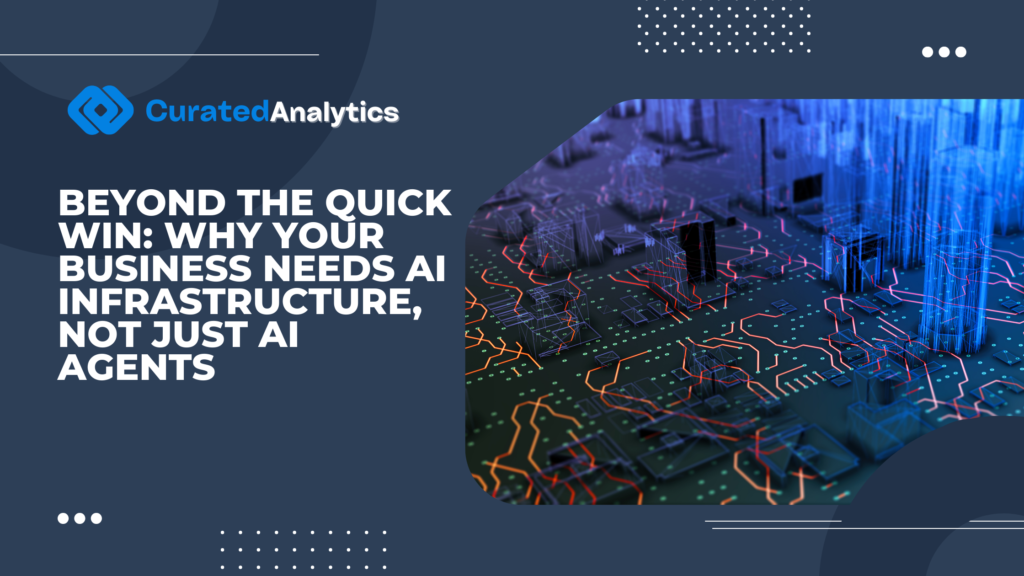The buzz around Artificial Intelligence is undeniable. Everywhere you turn, there’s talk of AI agents, chatbots, and automated tools promising to revolutionize aspects of your business. It’s tempting, as a business leader, to jump straight into deploying these seemingly plug-and-play solutions – a chatbot for customer service here, an automation tool for marketing there. These “AI Agents” offer quick wins and visible progress.
But while these agents are valuable, focusing solely on them is like buying power tools without building a workshop. You might be able to complete a few specific tasks, but you lack the foundation for sustained, scalable, and strategic impact. What your business truly needs for long-term AI success is AI Infrastructure.
Let’s break down the difference and why it matters.
What are AI Agents?
Think of AI Agents as specialized, often pre-trained AI models designed for specific tasks. Examples include:
• Chatbots: Handling customer inquiries.
• Content Generators: Assisting with marketing copy or reports.
• Data Entry Bots: Automating repetitive data input.
• Simple Recommendation Engines: Suggesting products based on past behavior.
They are typically relatively easy to implement, target narrow problems, and can deliver immediate, localized value. They are the visible “apps” of the AI world.
What is AI Infrastructure?
AI Infrastructure is the underlying foundation – the systems, processes, and resources – that enables the development, deployment, management, and scaling of AI across your entire organization. It encompasses:
• Data Pipelines & Storage: Robust systems for collecting, cleaning, storing, and accessing the vast amounts of high-quality data AI relies on.
• Compute Resources: Scalable processing power (cloud-based or on-premises) to train and run complex AI models.
• Model Development & Management Platforms (MLOps): Tools for building, training, deploying, monitoring, and retraining AI models efficiently and reliably.
• Governance & Security Frameworks: Policies and technical controls to ensure AI use is ethical, compliant, secure, and aligned with business goals.
• Integration Capabilities: Mechanisms to connect AI insights and actions seamlessly into existing business workflows and systems (ERP, CRM, etc.).
• Monitoring & Analytics: Tools to track AI performance, measure ROI, and identify areas for improvement.
Essentially, AI Infrastructure is the “operating system” and the “factory floor” for all your AI initiatives.
Why “Just Agents” Isn’t Enough: The Need for Infrastructure
Deploying individual agents without a supporting infrastructure might seem efficient initially, but it quickly leads to significant challenges:
• Data Silos: Each agent often works in isolation, creating fragmented data and duplicated efforts.
• Limited Scalability: Without shared infrastructure, adding new AI capabilities becomes costly and inconsistent.
• Governance Gaps: Lack of oversight can lead to ethical, legal, or compliance risks.
• Inefficiencies: Teams spend time managing tools instead of creating value.
• Missed Opportunities: Insights from one system aren’t leveraged across the business.
Think Long-Term: Build the Infrastructure First
AI agents can absolutely be part of your strategy, but they should sit atop a well-designed AI infrastructure. By investing in that foundation, your business can:
• Deploy AI more quickly and confidently
• Adapt to evolving technology and regulations
• Reduce risk and inefficiencies
• Unlock AI’s full value across departments
Conclusion
Quick wins are appealing. But for AI to drive real, lasting business transformation, your focus must extend beyond agents to the infrastructure that supports them. It’s not about picking a few tools — it’s about building an intelligent, agile, and future-ready organization.
Further Reading
Ready to turn a solid AI foundation into real results? Start with our step-by-step AI implementation roadmap to move from vision to execution. Make sure the framework you build is trustworthy by reviewing why strong AI governance matters, and don’t overlook security—see the key security issues in AI agent design before you scale. Together, these resources complement a robust AI infrastructure strategy and keep quick wins from becoming long-term headaches.

